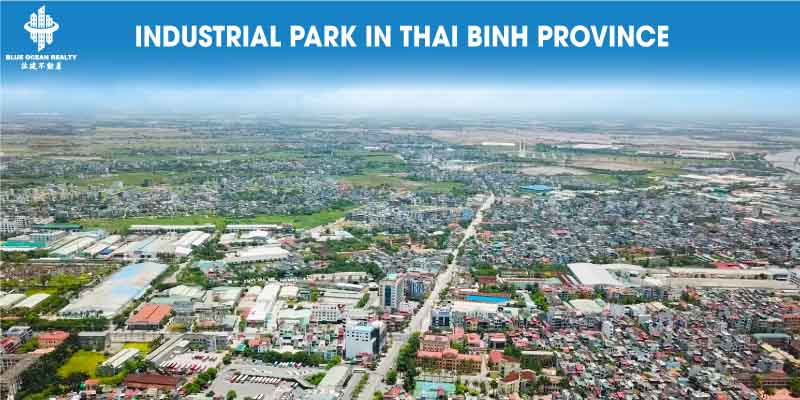Industrial Parks in Thai Binh Province Attract Investment
Thai Binh is a land of rivers, surrounded by three major rivers: the Red River to the west and southwest, bordering Ha Nam and Nam Dinh provinces; the Luoc River to the north, bordering Hung Yen and Hai Duong provinces; and the Hoa River to the east, bordering Hai Phong City. The eastern border also faces the sea, with over 50 km of coastline along the Gulf of Tonkin. With its rich river network, Thai Binh resembles a “floating island” formed by the alluvial deposits of the Red and Thai Binh River systems.
Situated in the Red River Delta, Thai Binh lies within the economic growth triangle of Hanoi, Hai Phong, and Quang Ninh. The province boasts a favorable geographical location: to the north, it borders Hung Yen, Hai Duong, and Hai Phong; to the west and southwest, it borders Nam Dinh and Ha Nam; and to the east, it borders the Gulf of Tonkin. Its road, river, and sea transportation networks are well-suited for economic development.
Urbanization and Population Growth
Thai Binh is experiencing rapid urbanization. By 2025, the province’s economic region is projected to have a population of 227,000, with an urbanization rate of about 41%. By 2040, the population is expected to reach 300,000, with an urbanization rate of 70%.
The total provincial population is 2,057,000 (2025). The Gross Regional Domestic Product (GRDP) for 2024 reached VND 76 trillion (~USD 3.2 billion), with a per capita GRDP of VND 40 million (~USD 1,700). The labor force training rate has reached 80%.
Infrastructure and Economy
Thai Binh has been approved by the government to develop the Thai Binh Economic Zone, covering over 30,583 hectares and located 35 km from Hai Phong City. The Thai Binh Power Center, with a capacity of 1,800 MW, has been connected to the national power grid, supporting industrial growth and attracting investment.
The province holds natural gas reserves exceeding 10 billion cubic meters, with an annual extraction capacity of 200 million cubic meters. Combining solar and wind energy, Thai Binh aims to establish a smart grid and attract investment from companies in the U.S., Japan, and South Korea.
In 2024, Thai Binh attracted seven FDI projects with a total investment of USD 600 million, focusing on industrial parks like Green IP-1. Total budget revenue reached VND 24 trillion, including VND 12 trillion from domestic sources.
Administrative Divisions
Thai Binh has eight administrative divisions at the district level: one city (Thai Binh City) and seven districts (Dong Hung, Hung Ha, Kien Xuong, Quynh Phu, Tien Hai, Vu Thu, and Thai Thuy), with 260 communes, wards, and towns.
Healthcare and Education
The province’s healthcare system includes 25 hospitals, eight medical centers, and 260 health stations. In education, Thai Binh has 295 preschools, 293 primary schools, 276 lower secondary schools, 39 upper secondary schools, two universities, four colleges, and 26 vocational training centers, training over 35,000 workers annually.
Tourism and Culture
Thai Binh is known for its cultural and historical relics such as Keo Pagoda, Dong Bang Temple, Tien Ca Temple, and Long Hung Palace. The province hosts nearly 30 traditional festivals and features handicraft villages specializing in silver engraving, embroidery, and mat weaving. Tourist attractions include Dong Chau Beach, Con Vanh, and Con Thu.
Transportation Infrastructure
Thai Binh has a well-developed network of road and waterway transportation. National highways such as NH10 and NH39, along with expressways connecting Hanoi, Hai Phong, and Quang Ninh, are being upgraded. Diem Dien Port is being modernized to accommodate 1,000-ton ships, boosting trade activities.
Industrial Parks in Thai Binh and Clusters in Thai Binh
Thai Binh has 10 industrial parks, six of which are operational with an occupancy rate of 82%. By 2025, industrial production value in these parks is expected to reach VND 50 trillion, accounting for 30% of the province’s total industrial output.
The province also has 44 industrial clusters spanning 2,253 hectares, attracting 439 investment projects and creating over 50,000 jobs. Industrial production value in these clusters is estimated to reach VND 35 trillion by 2025.
Development Goals
Thai Binh aims to become a leading province in the Red River Delta. Between 2025 and 2030, the province will focus on developing modern industry, ensuring sustainable growth, and attracting investment, especially in key economic zones and industrial parks.

(Note: all information above is for reference only. Actual information will be calculated according to the current time)

—
Your trusted partner in Vietnam Real Estate, Industrial Parks, and Invest Vietnam.
Stay Connected:
- Fanpage: blueoceanrealtyvn
- Youtube: BlueOceanRealty , @batdongsanbor , @blueoceanrealtyvietnam
- Instagram: blueoceanrealtyvn
- Tiktok: @bortintuc

—





